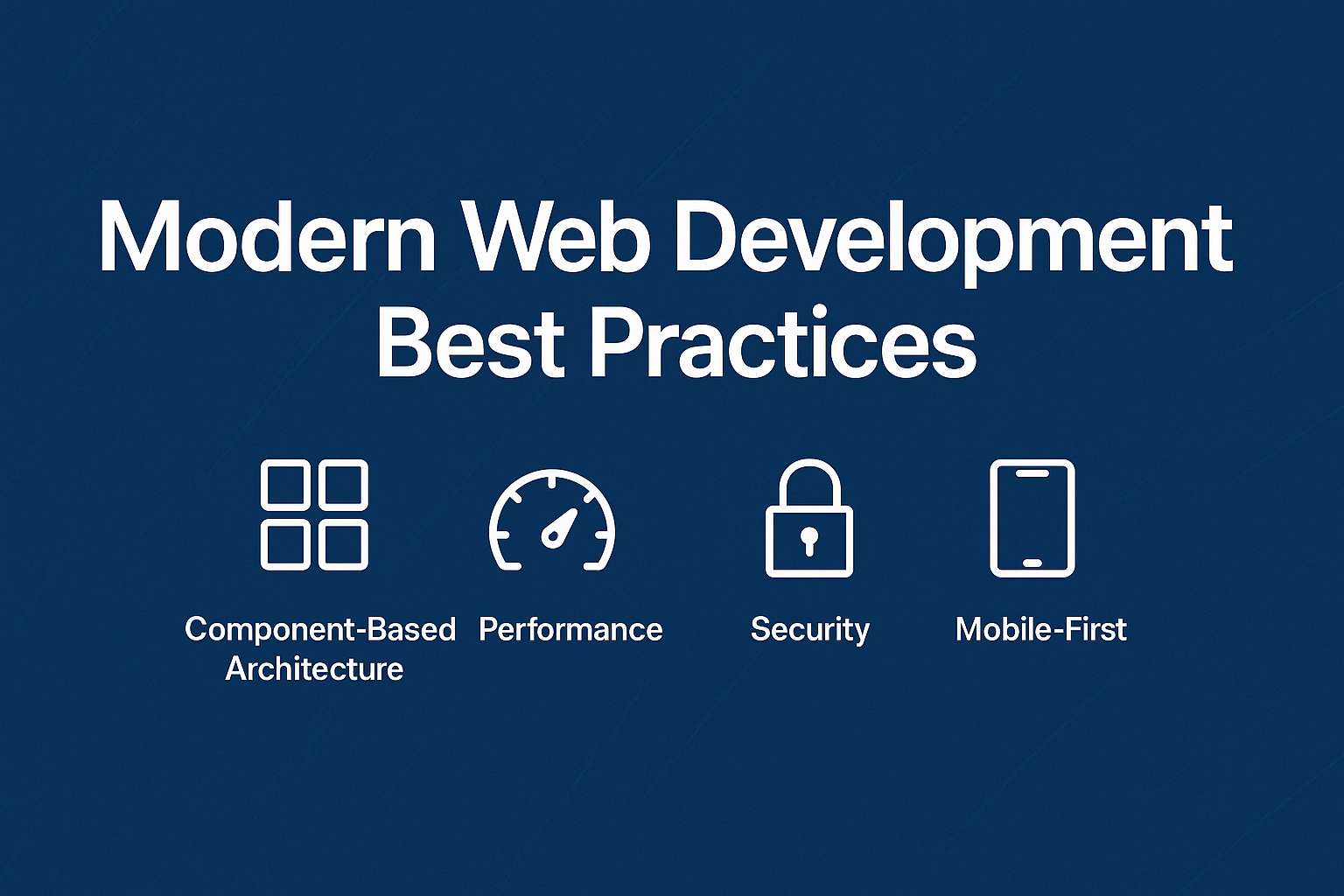In today’s fast-paced digital world, building high-performing, secure, and scalable websites is no longer optional—it’s expected. Modern web development best practices ensure your site meets current performance standards, user expectations, and SEO requirements.
Whether you’re developing a business site, SaaS platform, or eCommerce store, following these best practices will help you build web applications that are responsive, accessible, and ready for the future.

What Are Modern Web Development Best Practices?
🔹 Key Trends in Web Development
Modern web development best practices are proven techniques, coding standards, and tools that developers use to create reliable, maintainable, and user-friendly websites or applications. These practices help improve:
- User experience
- Site performance
- Security
- SEO rankings
- Code maintainability
🔹 Use a Component-Based Architecture
Component-based frameworks like React, Vue, and Angular break down the UI into modular components. This approach increases maintainability and allows reusability.
Example:
Instead of writing a form repeatedly, create a <FormInput /> component and reuse it across your application.
Benefits:
- Easier testing and debugging
- Consistent UI
- Scalable structure
🔹 Prioritize Performance Optimization
Speed impacts user satisfaction and search engine rankings. Websites should load quickly and operate smoothly across devices.
Best Practices:
- Compress images (use WebP or AVIF)
- Minify CSS and JavaScript
- Implement lazy loading
- Use a Content Delivery Network (CDN)
Example:
Use loading="lazy" on <img> tags to delay image loading until needed, reducing initial load time.
🔹 Apply Strong Security Standards
Security is critical to protecting both your users and your platform.
Implementation Tips:
- Always use HTTPS
- Sanitize user inputs
- Prevent Cross-Site Scripting (XSS) and SQL Injection
- Use secure authentication (JWT, OAuth)
Example:
Use libraries like Helmet.js in Node.js to set secure HTTP headers automatically.
🔹 Mobile-First and Responsive Design
Over half of web traffic comes from mobile devices. A mobile-first approach ensures accessibility and usability across screen sizes.
Techniques:
- Use media queries in CSS
- Build with Flexbox and Grid layouts
- Optimize images and buttons for touch interactions
Example:
Start designing your layout for screens 375px wide (iPhone width), then scale up.
🔹 Implement Web Accessibility (a11y)
Making your website accessible improves user experience for everyone, including those with disabilities, and also boosts SEO.
Guidelines:
- Use semantic HTML (
<header>,<nav>,<main>,<footer>) - Provide alt text for all images
- Ensure good color contrast
- Enable keyboard navigation
Example:
Add alt="Modern Web Development Best Practices" to your blog post image to describe it for screen readers.
🔹 Maintain Clean, Modular Code
Well-structured code is easier to read, debug, and scale.
Tips:
- Use consistent naming conventions
- Keep functions short and focused
- Avoid code duplication
- Separate concerns (e.g., logic, UI, and styles)
Example:
Follow the Single Responsibility Principle: each component or function should do one thing well.
🔹 Use Modern Development Tools
Leverage tools that streamline development and increase productivity.
Popular Tools:
- Vite or Webpack – for fast builds
- ESLint and Prettier – for code consistency
- Docker – for environment replication
- Git – for version control
Example:
Set up Prettier to auto-format code on save and keep your entire team consistent.
🔹 Test and Monitor Your Application
Testing improves reliability and ensures your app works as intended across scenarios.
Types of Testing:
- Unit tests (e.g., Jest)
- Integration tests
- End-to-end (E2E) tests (e.g., Cypress)
Monitoring Tools:
- Google Analytics – track performance and traffic
- Sentry – monitor frontend errors
- LogRocket – review user sessions
🔹 Optimize for SEO
SEO isn’t just for marketers. Developers must structure websites in a way that is crawlable and indexable by search engines.
SEO Best Practices:
- Use semantic HTML tags
- Add descriptive meta tags
- Create clean, keyword-rich URLs
- Implement structured data (Schema.org)
- Compress and optimize media files
Example:
Use a descriptive URL like /modern-web-development-best-practices instead of /blog123.
🔹 Keep Learning and Updating
Web standards evolve. Modern developers must keep up with frameworks, libraries, and emerging technologies.
Suggestions:
- Follow industry blogs (Smashing Magazine, CSS-Tricks, MDN)
- Subscribe to newsletters (Frontend Focus, JavaScript Weekly)
- Contribute to open-source or peer code reviews
Final Thoughts
Adopting modern web development best practices helps you create faster, safer, and smarter websites. From responsive design to accessibility, clean code to SEO, these principles are the backbone of successful digital products in 2025 and beyond.
Start small. Improve continuously. Build better.



I am student of Information Technology in 5th sem At Tulsiramji Gayakwad Patil College of engineering and technology, Nagpur
I am applying for the Front-end Development
I am applying for the Web Development
I am applying for the Web Development
Iam interested in Modern web development because I have worked web development project in my accademy year iam recently graduated student from Geethanjali college of engineering and technology i have skill I need good environment to show case my skill
I am applying for Web development
…
Hii, I’m Mahak gupta. I’m live in satna. Current I have completed my graduation from Information Technology Bansal Institute of Science & Technology. I have created two Full stack project. I’m searching for Frontend developer job/ internship.
I’m interested
I’m a web developer and App Developer with 3 years of experience
How to apply web development
I am applying for Web Development
Hello ,hope this message finds you well.
My name is Rony Ghanem, and I am a recent graduate with a Master’s degree in Management Information System. I am actively seeking junior-level opportunities or internships where I can contribute my skills and continue developing professionally.Thank you for considering my application. 🙏I look forward to hearing from you.
I am applying for web development
#Interested
I am applying for web development
I’m Ayesha Eman, a frontend web developer from Pakistan. I have 6 months of internship experience and currently pursuing a DIT diploma. I have built multiple responsive websites using HTML, CSS, JavaScript, and I’m learning React. I’m actively looking for frontend developer internships or jobs.
GitHub: https://github.com/ayesha5257
Contact: +92 346 9379367
Email: emanwebbar@gmail.com
Thank you!